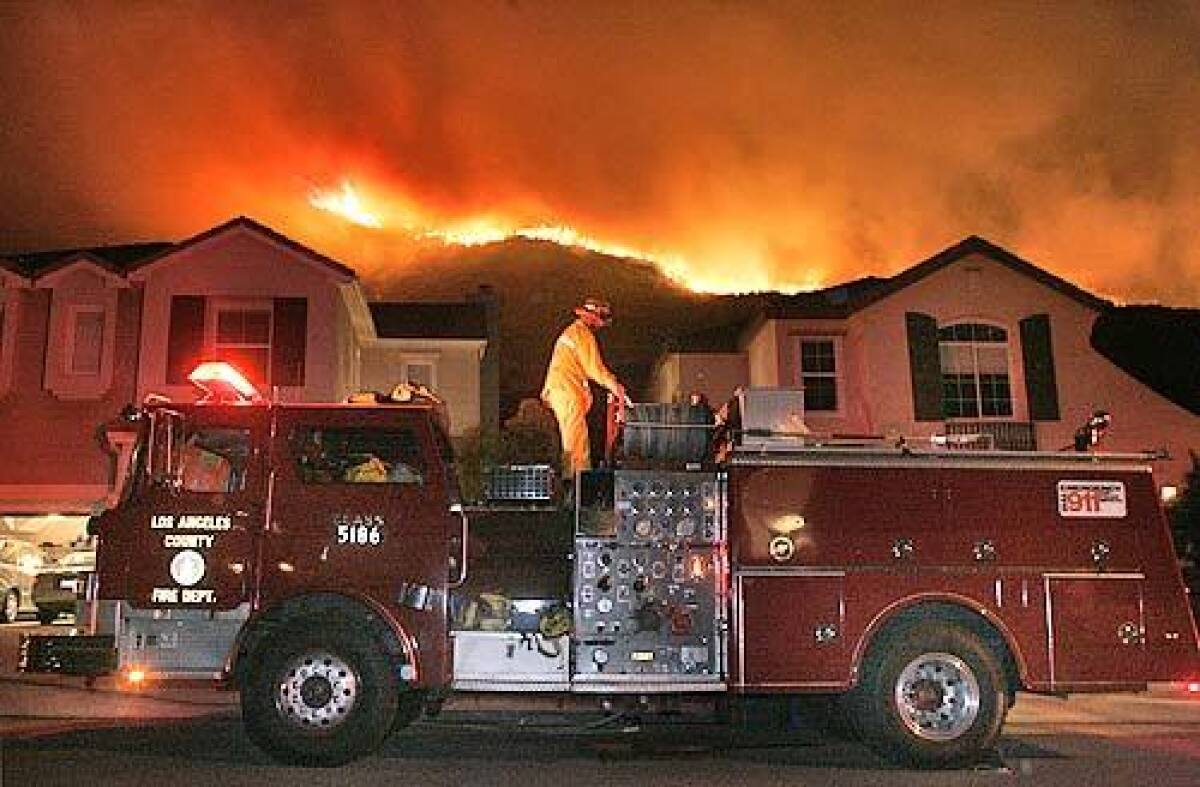Strained by wildfires, L.A. County firefighters want voters to approve a tax increase

A proposed increase to the parcel tax would finance a multimillion-dollar investment in Los Angeles County Fire Department.
- Share via
The Los Angeles County Fire Department plans to ask voters for more money next year, as commanders scramble for more resources to respond to increasingly destructive wildfires and a growing volume of medical calls.
A proposed parcel tax, which the L.A. County Board of Supervisors is expected to consider next week, would collect an estimated $130 million a year from most residents in the department’s 2,300-square-mile jurisdiction — a sprawling area that runs from Malibu to Pomona and includes the county’s beaches.
Department officials say the extra revenue would be used to hire more firefighters and paramedics, and to finance equipment and infrastructure improvements for new communications technology.
The department’s 911 software, for example, dates to the 1980s, with outdated tools for mapping cellphone calls. New fire stations have opened in recent years, but others need repairs. And its fleet of fire engines is aging, officials say.
“The primary objective of the ballot measure, if approved by the voters, is the primary mission of the department: To get more boots on the ground, so they can do their jobs, and for me as the fire chief, and my administrative team, to provide them with the equipment and technical tools they need to do their jobs,” Chief Daryl Osby told The Times from the department’s hilltop headquarters in East Los Angeles.
The parcel tax would collect 6 cents per square foot in most places where the department offers service. The 4,600-person department currently has 174 stations throughout the county and lifeguard posts along 70 miles of shoreline, covering dozens of cities and more than 4 million residents.
It would not apply to cities with their own fire departments, such as Culver City, Pasadena or Los Angeles.
The Board of Supervisors is scheduled to decide next week whether place the tax on the March ballot.
Supervisor Janice Hahn, the board chair whose district stretching from Marina del Rey to Diamond Bar has at least 12 cities covered by the department, said the additional funding is necessary.
“There is no better investment than investing in the men and women who could save your life, whether that is in a fire or a medical emergency,” said Hahn. “When you call 911, you want enough firefighters and paramedics on duty — and you want them to have the modern equipment they need to save your life.”
The department is a special district with a $1.2-billion budget that comes primarily from property taxes, contracts for service and fees — not the county’s general fund. So despite the supervisors’ support, they can’t allocate the additional resources fire commanders say they need.
There were roughly 330,000 medical calls last year, up from 205,000 in 2008 — a 60% increase. The growth in calls has outpaced population change, as the residents the department serves age and others newly insured under the Affordable Care Act have become more willing to seek medical attention.
“All the calls have gone up. But by far the largest increase has been the increase in general medical calls,” said Clayton Kazan, an emergency physician who serves as the department’s medical director.
To meet a steady increase in demand, and commanders say they need an additional 10 fire engine companies and 20 to 25 paramedic squads — which means hundreds of new employees.
The strain on the department also shows in its payroll, where overtime spending has increased by more than 40% in the last eight years, according to records maintained by the California State Controller’s office.
Department officials say they have to ask or require firefighters to work extra shifts, especially during wildfire season.
Larger overtime budgets continue to worry local policy makers — especially after the Woolsey fire last year exposed limitations in the state’s system of gathering neighboring departments to help one another.
“My focal point is really focused on the need,” said Osby, the fire chief. “We do need more firefighters and paramedics. We do need up-to-date apparatus and communications systems and equipment. That will enable our firefighters and paramedics to execute their mission more effectively.”
More to Read
Sign up for Essential California
The most important California stories and recommendations in your inbox every morning.
You may occasionally receive promotional content from the Los Angeles Times.














